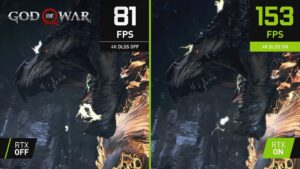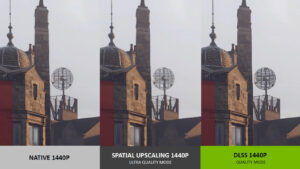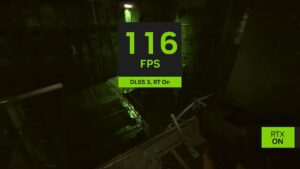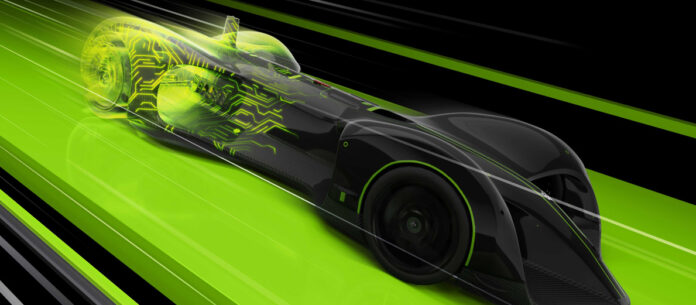About 10 years ago, 4K monitors started appearing in our stores . These displays had incredibly clear images, and gamers started buying them en masse, but they quickly discovered that their video cards couldn’t handle games at 3840×2160 pixels. Even owners of top-end graphics accelerators, such as the NVIDIA GeForce GTX 1080 Ti, couldn’t count on high FPS.
In 2018, NVIDIA introduced a solution to this problem – AI-powered anti-aliasing DLSS. Below, we’ll explain what NVIDIA DLSS is without going into complex technical details.
Why DLSS is called a revolution
Anti-aliasing is an algorithm that removes “jaggies” on the edges of objects. Many of them have been developed, but the most popular of them are: MSAA, SMAA and TAA. All these algorithms have one thing in common: a decrease in frame rate. That is, when they are enabled, the FPS in games decreases.
With the DLSS algorithm, it’s the other way around. It’s anti-aliasing that doesn’t reduce, but increases the frame rate. And it does it very well. You can achieve a twofold, and sometimes even a threefold increase in FPS. No other anti-aliasing can do that.

How DLSS Works and Why Does it Increase FPS
The increase in frame rate comes at the expense of lowering the resolution. Let’s say you’re running a game at 3840×2160, or 4K. When you enable DLSS antialiasing and select the “Quality” mode, the game starts outputting the image to your monitor at a lower resolution, namely 2560×1440. Then the neural network is launched, which finishes rendering the image to your display’s resolution.
So, to be more precise, DLSS is not only anti-aliasing, but also an upscaling technology. The algorithm launches the game at a lower resolution, and then uses a neural network to draw the missing pixels to the resolution of your monitor.
Why DLSS Wasn’t Created Earlier
Tensor cores, special computing units inside NVIDIA graphics processors, are responsible for reconstructing images from low to high resolution. These units multiply data matrices. This is what the working algorithms of all modern neural networks are based on.
Previously, tensor cores were installed only in professional NVIDIA TITAN video cards, but in 2018 they began to be added to regular gaming cards of the GeForce line. So it was simply impossible to create DLSS technology earlier.
By the way, tensor and RT cores have become the main feature of NVIDIA 20-series graphics accelerators. The technological leap was so huge that NVIDIA decided to rename the new video cards. Previously, they were called GTX, and now RTX. With this, the company wanted to once again demonstrate the technological breakthrough that it managed to make.
Is it true that DLSS blurs the picture?
To begin with, let us clarify that in computer graphics, “soap” refers to a loss of clarity and detail, when the boundaries of objects seem to blur.
Indeed, the first versions of DLSS, which were used in Battlefield V and Metro Exodus, greatly blurred the picture, but with the release of DLSS 2.0, everything changed.
DLSS 2.0 is the next version of anti-aliasing, which was released in 2020. Without going into the technical details, it differed from the first one in the following ways:
- easy integration into the game;
- less soap;
- the ability to choose quality presets.
Easy integration into the game
To add DLSS anti-aliasing to their project, developers first passed the game files to NVIDIA, which ran those files through the DGX SATURNV supercomputer and trained a neural network to reconstruct the image.
With the release of DLSS 2.0, this was no longer necessary. Now developers simply added DLSS files to their game, and anti-aliasing would automatically start working. No additional runs through a supercomputer were required.
It was after the release of the second version of DLSS that developers began to add this anti-aliasing to games en masse. In May 2023, NVIDIA reported that more than 300 games and applications had already received DLSS support.
Less soap
The quality of reconstruction in the new version of anti-aliasing has improved significantly. When DLSS was turned on in the “Quality” mode, the result was as follows:
- on Full HD monitors the picture was a bit blurry;
- on 2K monitors the picture was almost not blurred;
- on 4K monitors the picture became clearer and more detailed;
- On 8K monitors the picture became much clearer and more detailed.
One of the main features of DLSS is the improvement in performance when the monitor resolution increases. NVIDIA explains this by the fact that the higher the display resolution, the more source data the neural network has for image reconstruction.

Possibility to choose quality presets
With the release of DLSS 2.0, gamers now have the ability to choose between 4 presets:
- Quality. FPS increases by about 30%.
- Balanced. FPS increases by about 50%.
- Performance. FPS increases by about 70%.
- Ultra performance. FPS increases by about 90%.
The Performance and Ultra Performance modes are impressive. They increase the frame rate by 1.5-2 times, but this comes at the cost of reconstructing the image from a lower resolution, which makes the picture very blurry even on 4K monitors. So we do not recommend enabling these modes.
How to improve clarity when DLSS is enabled
There is a post-processing effect called “Sharpen”. It is very popular and is even available in your smartphone’s photo editor. This effect outlines the contours of objects, which increases the overall clarity of the image.
Sharpness is also available in video games. If you have GeForce Experience installed on your PC (usually it is installed to install drivers for the video card), then when you press the Alt and F3 keys, a window with various effects will appear in the game. Select Sharpness and adjust its intensity. This will increase clarity and compensate for the blurring that DLSS creates on monitors with a low resolution.
Many modern games have sharpness settings directly in the graphics settings. You don’t have to enable this effect through the NVIDIA GeForce Experience menu.
What is DLSS 3.5 and frame generation
After the success of DLSS 2.0, NVIDIA turned this technology into a kind of brand and bragged about it everywhere. In fact, it had every right to do so, because the development really turned out to be revolutionary. But with the release of DLSS 3.0 in 2022, gamers got confused. Many thought that NVIDIA released a new version of anti-aliasing, but in reality, it created another technology, which they decided to combine into one brand with DLSS. We are talking about frame generation.
Later, NVIDIA released another technology – ray tracing reconstruction. They also decided to combine it into one brand with DLSS. So in 2023, DLSS 3.5 technology appeared – a collective name for three different algorithms at once:
- DLSS 2.0;
- frame generation;
- ray tracing reconstructions.
All the presented technologies have in common the fact that tensor cores are responsible for their work. Most likely, this is why NVIDIA decided to combine them into one brand.
Next, we’ll talk in detail about frame generation and ray tracing reconstruction.

What is frame generation
Frame generation creates intermediate frames between real ones, which allows to increase FPS in games by 2-3 times. However, this technology only seems good. In reality, it creates a lot of artifacts that do not allow you to enjoy the graphics. Moreover, the number of artifacts increases with decreasing resolution. That is, on 4K monitors there are few of them, but on Full HD displays, on the contrary, there are a lot of them, and they interfere with playing.
With each new driver, the frame generation technology improves. Most likely, it will repeat the path of DLSS and will work better in the future. But today, it is not worth turning on. The time for this technology has not yet come.
Frame generation is an exclusive technology of NVIDIA 40-series. If you have a video card of 20-series or 30-series, you will not be able to enable generation. This function will be blocked in the graphics settings of games that support it. According to NVIDIA, older video cards have rather weak tensor cores, which cannot ensure fast and stable operation of the generator.

What is Ray Tracing Reconstruction
When ray tracing is enabled, a huge amount of noise is generated – grain artifacts that spoil the image. A special algorithm is responsible for their elimination – denoising. It eliminates noise very well, but at the same time spoils the quality of ray tracing effects.
Reflections suffer the most, starting to look blurry. Global illumination quality also deteriorates, and some areas may darken incorrectly or not at all.
Ray tracing reconstruction is a technology that solves the problems of dinozing and improves the quality of ray tracing effects. If you see this technology in the graphics settings, be sure to enable it if you decide to play with ray tracing.
Almost all mid- and high-budget games released today support DLSS technology. If a game does not have this anti-aliasing at release, then most likely modders will add it. After all, DLSS files are in the public domain.
This is exactly what happened with the game Starfield. The project did not support DLSS at release, and users began to install it themselves. The developers found out about this and released a patch in which they officially added DLSS to the game’s graphics settings.
Why DLSS Doesn’t Work on AMD Cards
We have already said that DLSS works due to the tensor cores that are installed in modern NVIDIA graphics processors. The problem is that AMD cards do not have these tensor cores. Therefore, running DLSS on “red” devices is impossible.
DLSS Technology in Games: Results
DLSS is a truly revolutionary anti-aliasing that does not reduce, but, on the contrary, increases FPS in games. Other features of the technology include:
- easy integration of DLSS into games;
- the ability to choose different quality presets;
- improving picture clarity by increasing display resolution.
Also, don’t forget that DLSS 3.5 is not one technology, but a name for three different algorithms at once.

